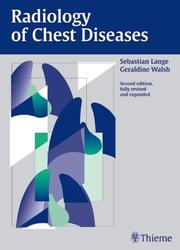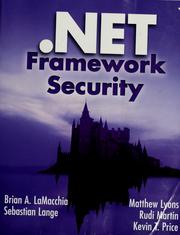| Listing 1 - 10 of 10 |
Sort by
|
Book
Year: 1969 Publisher: Berlin [s.n.]
Abstract | Keywords | Export | Availability | Bookmark
 Loading...
Loading...Choose an application
- Reference Manager
- EndNote
- RefWorks (Direct export to RefWorks)

ISBN: 3137407028 Year: 1998 Publisher: Stuttgart : Thieme,
Abstract | Keywords | Export | Availability | Bookmark
 Loading...
Loading...Choose an application
- Reference Manager
- EndNote
- RefWorks (Direct export to RefWorks)
Cardiovascular diseases --- Lung diseases --- Lung --- Thoracic radiography. --- Radiography. --- Radiography. --- Radiography.

ISBN: 3137407036 9783137407034 1588904474 9781588904478 Year: 2007 Publisher: Stuttgart : Thieme,
Abstract | Keywords | Export | Availability | Bookmark
 Loading...
Loading...Choose an application
- Reference Manager
- EndNote
- RefWorks (Direct export to RefWorks)
Book
ISBN: 3131002611 Year: 1995 Publisher: Stuttgart : Thieme,
Abstract | Keywords | Export | Availability | Bookmark
 Loading...
Loading...Choose an application
- Reference Manager
- EndNote
- RefWorks (Direct export to RefWorks)
Urinary organs --- Urography --- Urologic diseases --- Urologic diseases, radiography --- Radiography --- Atlases. --- Methods --- Atlases. --- Radiography --- Atlases. --- Atlases.
Book
ISBN: 3839440823 3837640825 Year: 2019 Publisher: Bielefeld transcript Verlag
Abstract | Keywords | Export | Availability | Bookmark
 Loading...
Loading...Choose an application
- Reference Manager
- EndNote
- RefWorks (Direct export to RefWorks)
Die militärische Terrorismusbekämpfung der letzten eineinhalb Jahrzehnte gilt heute als kontraproduktiv. Hat der »War on Terror« die dschihadistischen Bewegungen tatsächlich gestärkt und ist er der Grund für ihre wachsende Anhängerzahl? Sebastian Langes kommunikations- und organisationstheoretischen Analysen gehen den Eskalationsmechanismen im Verhältnis von transnationalem Terrorismus und staatlicher Terrorismusbekämpfung nach. Die Studie zeigt: Der Identitätskonflikt zwischen modernen Gesellschaften und fundamentalistischer Weltanschauung lässt sich nur dann entschärfen, wenn sicherheitspolitische Überreaktionen vermieden werden. Besprochen in: Portal für Politikwissenschaft, 06.05.2020, Volker Stümke
Terrorism, armed struggle --- Al-Qaeda. --- Communication. --- Constructivism. --- Fundamentalism. --- Globalization. --- Islamic State. --- Jihadism. --- Policy. --- Political Science. --- Political Theory. --- Politics. --- Systems Theory. --- Violence. --- War on Terror. --- Terrorismus; War on Terror; Terrorismusbekämpfung; Dschihadismus; Fundamentalismus; Al-Qaida; Islamischer Staat; Sicherheitspolitik; Kommunikation; Systemtheorie; Konstruktivismus; Politik; Gewalt; Globalisierung; Policy; Politische Theorie; Politikwissenschaft; Terrorism; Jihadism; Fundamentalism; Al-Qaeda; Islamic State; Communication; Systems Theory; Constructivism; Politics; Violence; Globalization; Political Theory; Political Science
Book
ISBN: 3921817005 Year: 1977 Publisher: Berlin : Schering,
Abstract | Keywords | Export | Availability | Bookmark
 Loading...
Loading...Choose an application
- Reference Manager
- EndNote
- RefWorks (Direct export to RefWorks)

ISBN: 067232184X Year: 2003 Publisher: Boston Addison-Wesley
Abstract | Keywords | Export | Availability | Bookmark
 Loading...
Loading...Choose an application
- Reference Manager
- EndNote
- RefWorks (Direct export to RefWorks)
Book
ISBN: 3805548567 Year: 1989 Publisher: Basel : Karger,
Abstract | Keywords | Export | Availability | Bookmark
 Loading...
Loading...Choose an application
- Reference Manager
- EndNote
- RefWorks (Direct export to RefWorks)
Brain --- Spinal cord --- Brain Diseases --- Spinal Diseases --- Tomography, X-Ray Computed. --- Tomography. --- Tomography. --- Diagnosis. --- Diagnosis.
Book

ISBN: 3642404022 3642404030 Year: 2013 Publisher: Berlin, Heidelberg : Springer Berlin Heidelberg : Imprint: Springer,
Abstract | Keywords | Export | Availability | Bookmark
 Loading...
Loading...Choose an application
- Reference Manager
- EndNote
- RefWorks (Direct export to RefWorks)
The Internet of Things (IoT) is an emerging network superstructure that will connect physical resources and actual users. It will support an ecosystem of smart applications and services bringing hyper-connectivity to our society by using augmented and rich interfaces. Whereas in the beginning IoT referred to the advent of barcodes and Radio Frequency Identification (RFID), which helped to automate inventory, tracking and basic identification, today IoT is characterized by a dynamic trend toward connecting smart sensors, objects, devices, data and applications. The next step will be “cognitive IoT,” facilitating object and data re-use across application domains and leveraging hyper-connectivity, interoperability solutions and semantically enriched information distribution. The Architectural Reference Model (ARM), presented in this book by the members of the IoT-A project team driving this harmonization effort, makes it possible to connect vertically closed systems, architectures and application areas so as to create open interoperable systems and integrated environments and platforms. It constitutes a foundation from which software companies can capitalize on the benefits of developing consumer-oriented platforms including hardware, software and services. The material is structured in two parts. Part A introduces the general concepts developed for and applied in the ARM. It is aimed at end users who want to use IoT technologies, managers interested in understanding the opportunities generated by these novel technologies, and system architects who are interested in an overview of the underlying basic models. It also includes several case studies to illustrate how the ARM has been used in real-life scenarios. Part B then addresses the topic at a more detailed technical level and is targeted at readers with a more scientific or technical background. It provides in-depth guidance on the ARM, including a detailed description of a process for generating concrete architectures, as well as reference manuals with guidelines on how to use the various models and perspectives presented to create a concrete architecture. Furthermore, best practices and tips on how system engineers can use the ARM to develop specific IoT architectures for dedicated IoT solutions are illustrated and exemplified in reverse mapping exercises of existing standards and platforms.
Engineering & Applied Sciences --- Computer Science --- Ubiquitous computing. --- Embedded Internet devices. --- Ambient intelligence. --- Radio frequency identification systems. --- Wireless communication systems. --- Communication systems, Wireless --- Wireless data communication systems --- Wireless information networks --- Wireless telecommunication systems --- Identification systems, Radio frequency --- RF/ID systems --- RFID systems --- AmI (Ambient intelligence) --- Intelligence, Ambient --- Embedded networking hardware --- Internet-based embedded devices --- Pervasive computing --- UbiComp (Computer science) --- Computer science. --- Production management. --- Management information systems. --- Special purpose computers. --- Software engineering. --- Application software. --- Computer Science. --- Information Systems Applications (incl. Internet). --- Business IT Infrastructure. --- Computer Appl. in Administrative Data Processing. --- Operations Management. --- Software Engineering. --- Special Purpose and Application-Based Systems. --- Human-computer interaction --- Ubiquitous computing --- Embedded computer systems --- Internet of things --- Electronic data processing --- Telecommunication systems --- Identification --- Radio telemetry --- Near-field communication --- Distributed processing --- Equipment and supplies --- Voice computing --- Information systems. --- Computer software engineering --- Engineering --- Manufacturing management --- Industrial management --- Computer-based information systems --- EIS (Information systems) --- Executive information systems --- MIS (Information systems) --- Sociotechnical systems --- Information resources management --- Management --- Communication systems
Digital

ISBN: 9783642404030 Year: 2013 Publisher: Berlin, Heidelberg Springer
Abstract | Keywords | Export | Availability | Bookmark
 Loading...
Loading...Choose an application
- Reference Manager
- EndNote
- RefWorks (Direct export to RefWorks)
The Internet of Things (IoT) is an emerging network superstructure that will connect physical resources and actual users. It will support an ecosystem of smart applications and services bringing hyper-connectivity to our society by using augmented and rich interfaces. Whereas in the beginning IoT referred to the advent of barcodes and Radio Frequency Identification (RFID), which helped to automate inventory, tracking and basic identification, today IoT is characterized by a dynamic trend toward connecting smart sensors, objects, devices, data and applications. The next step will be “cognitive IoT,” facilitating object and data re-use across application domains and leveraging hyper-connectivity, interoperability solutions and semantically enriched information distribution. The Architectural Reference Model (ARM), presented in this book by the members of the IoT-A project team driving this harmonization effort, makes it possible to connect vertically closed systems, architectures and application areas so as to create open interoperable systems and integrated environments and platforms. It constitutes a foundation from which software companies can capitalize on the benefits of developing consumer-oriented platforms including hardware, software and services. The material is structured in two parts. Part A introduces the general concepts developed for and applied in the ARM. It is aimed at end users who want to use IoT technologies, managers interested in understanding the opportunities generated by these novel technologies, and system architects who are interested in an overview of the underlying basic models. It also includes several case studies to illustrate how the ARM has been used in real-life scenarios. Part B then addresses the topic at a more detailed technical level and is targeted at readers with a more scientific or technical background. It provides in-depth guidance on the ARM, including a detailed description of a process for generating concrete architectures, as well as reference manuals with guidelines on how to use the various models and perspectives presented to create a concrete architecture. Furthermore, best practices and tips on how system engineers can use the ARM to develop specific IoT architectures for dedicated IoT solutions are illustrated and exemplified in reverse mapping exercises of existing standards and platforms.
Office management --- Physical distribution --- Production management --- Computer science --- Information systems --- Computer. Automation --- bedrijfseconomie --- RFID (radio frequentiële identificatie) --- SCM (supply chain management) --- IoT (Internet of Things) --- computers --- informatica --- bedrijfsadministratie --- informatiesystemen --- productie --- kapitalisme --- software engineering --- logistiek --- informatica management --- computerkunde
| Listing 1 - 10 of 10 |
Sort by
|

 Search
Search Feedback
Feedback About
About Help
Help News
News